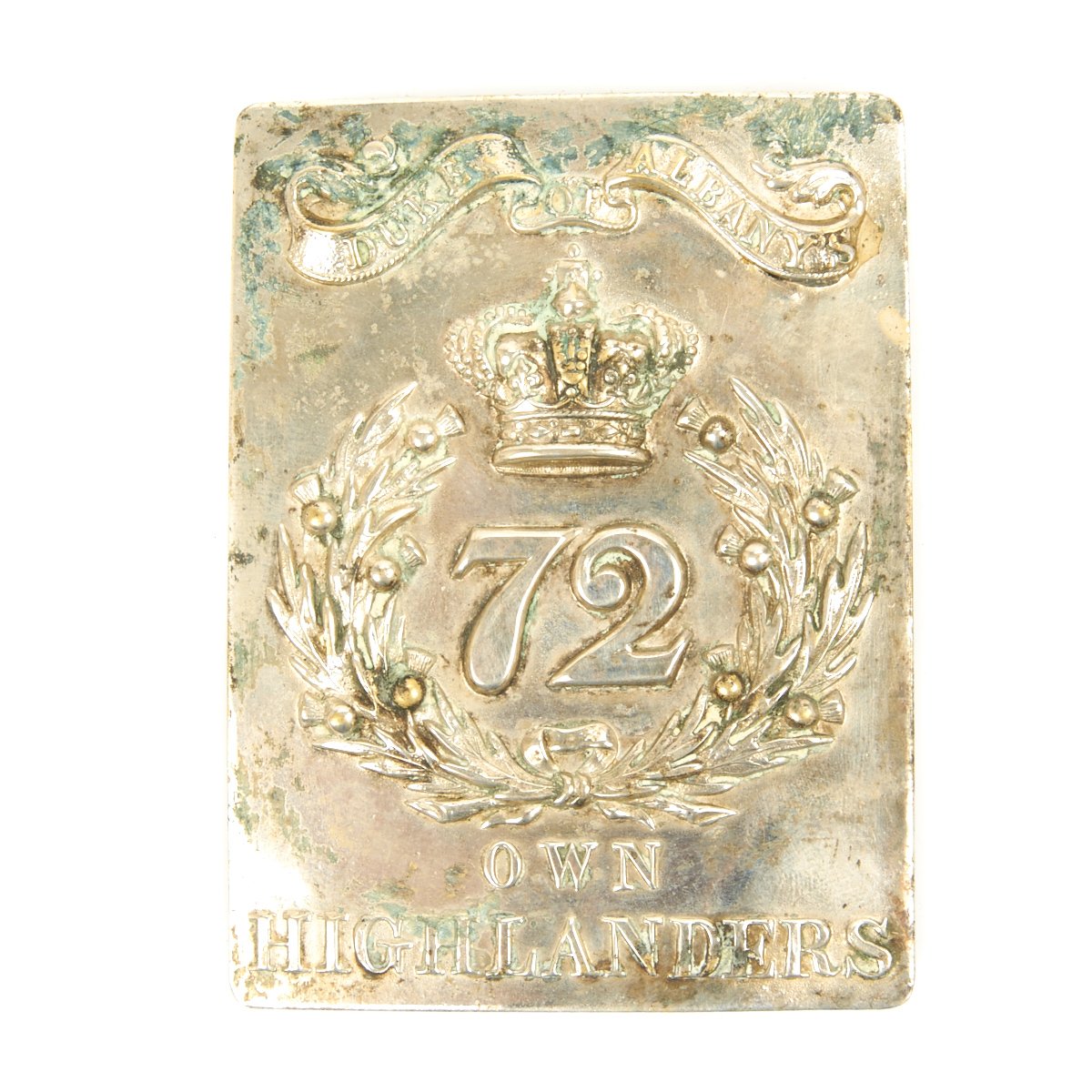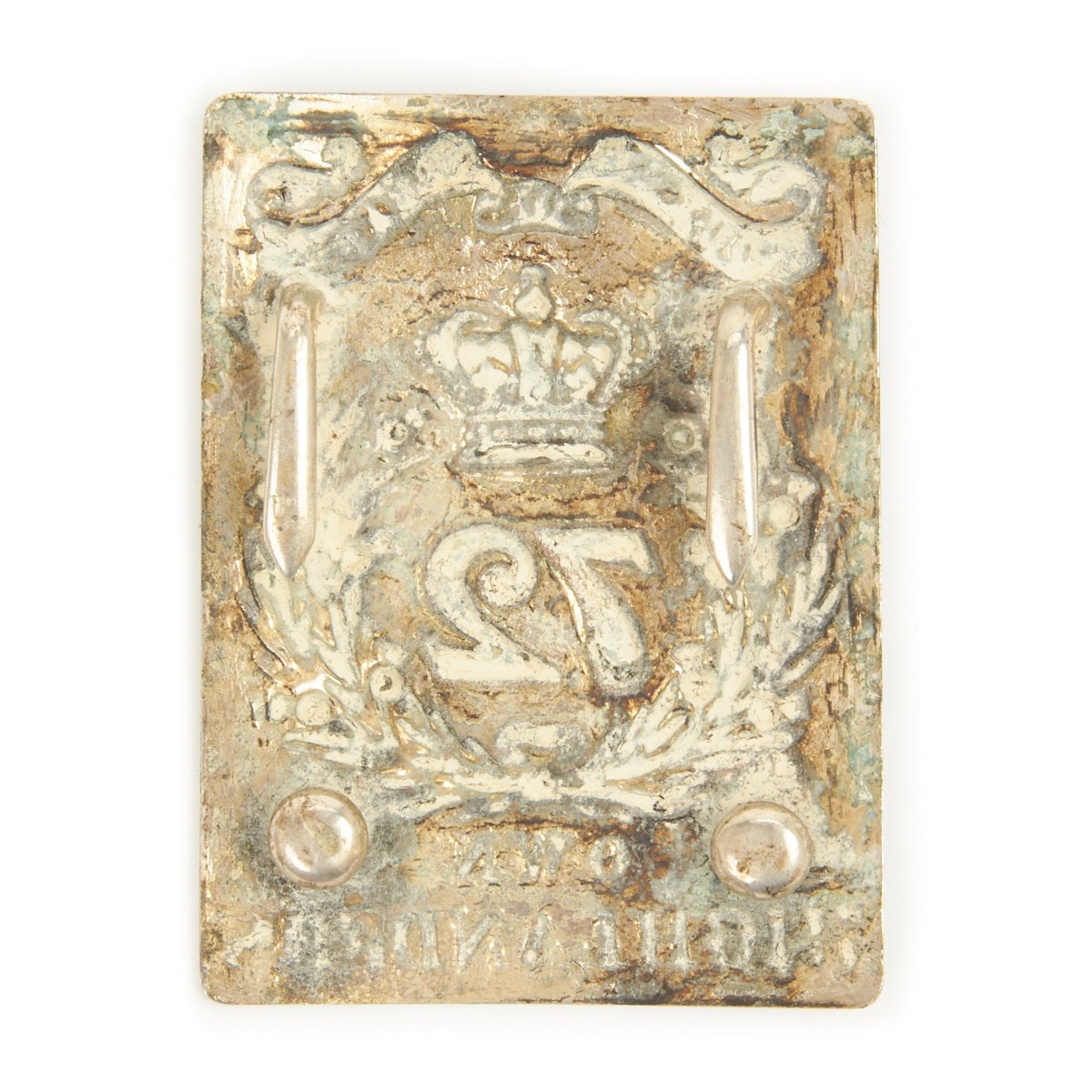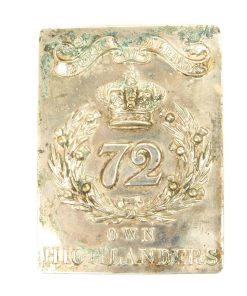Original British Early 19th Century Cross Belt Plate from the 72nd Highland Regiment of Foot Original Items
$ 325,00 $ 97,50
Original Item: Only One Available. A Cross Belt plate was worn on the white buff belt slung across an Infantryman’s shoulder and chest, very often to carry his ammunition pouch. In the case of Officers, the Cross Belt plate was used to carry the Infantry Sword. The plate displays the Royal Crown over regimental designation 72, surrounded by laurel leaves, and the DUKE OF ALBANY’S OWN HIGHLANDERS on the top and bottom.
The plate measures just over 2 3/4″ X 3 3/4″ and is slightly curved and constructed of what appears to be silver. However the plate bears no apparent Hall Marks, so it is probably silver plated brass. Officer’s cross Belt plates were often made of Sterling Silver.
The 72ND REGIMENT OF FOOT was raised in 1778 as the SEAFORTH HIGHLAND REGIMENT. It served in the British Channel Island of JERSEY in May 1779 to repulse a French Invasion force. It moved on to British India in 1782 to take part in the Second Anglo-Mysore war of 1783. It took part in the Third Anglo-Mysore War of 1789 and partook in the Sieges/Battles of Bangalor 1791, Savdroog also in 1791, Seringpatam in 1792 and Pondicherry in 1793. It returned to England in 1798.
The regiment was renamed the 72nd (or Duke of Albany’s Own Highlanders) Regiment of Foot after Prince Frederick, Duke of York and Albany in December 1823. It served in the Crimean War in 1855 at the Battle of Sevastopol, the Indian Mutiny in 1857, The Ambela Campaign in 1863 and the Second Anglo-Afghan War of 1880.
Much traveled, very experienced, one of Britain’s best Scottish Regiments.
Fast Shipping with Professional Packaging
Thanks to our longstanding association with UPS FedEx DHL, and other major international carriers, we are able to provide a range of shipping options. Our warehouse staff is expertly trained and will wrap your products according to our exact and precise specifications. Prior to shipping, your goods will be thoroughly examined and securely secured. We ship to thousands clients each day across multiple countries. This shows how we're dedicated to be the largest retailer on the internet. Warehouses and distribution centres can be located throughout Europe as well as the USA.
Note: Orders with more than one item will be assigned a processing date depending on the item.
Before shipping before shipping, we'll conduct a thorough inspection of the items you have ordered. Today, the majority of orders will be delivered within 48 hours. The delivery time will be between 3-7 days.
Returns
The stock is dynamic and we cannot completely manage it because multiple stakeholders are involved, including our factory and warehouse. So the actual stock may alter at any time. It's possible that you may not receive your order once the order has been made.
Our policy is valid for a period of 30 days. If you don't receive the product within 30 days, we are not able to issue a refund or an exchange.
You can only return an item if it is unused and in the same state as the day you received it. You must have the item in its original packaging.
Related products
Uncategorized
Uncategorized
Uncategorized
Uncategorized
Uncategorized
Uncategorized
Uncategorized
Uncategorized
Uncategorized
Uncategorized
Uncategorized
Uncategorized
Uncategorized
Angolan Rebel 1970s era 60mm Inert Display Mortar from Angolan Civil War Original Items
Uncategorized
Uncategorized
Uncategorized
Uncategorized
Uncategorized
Uncategorized
Uncategorized







































































